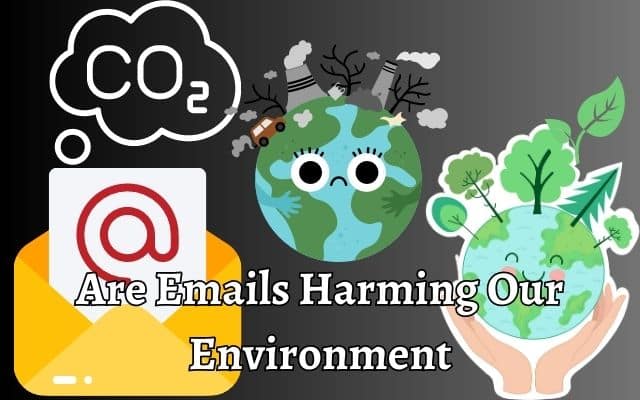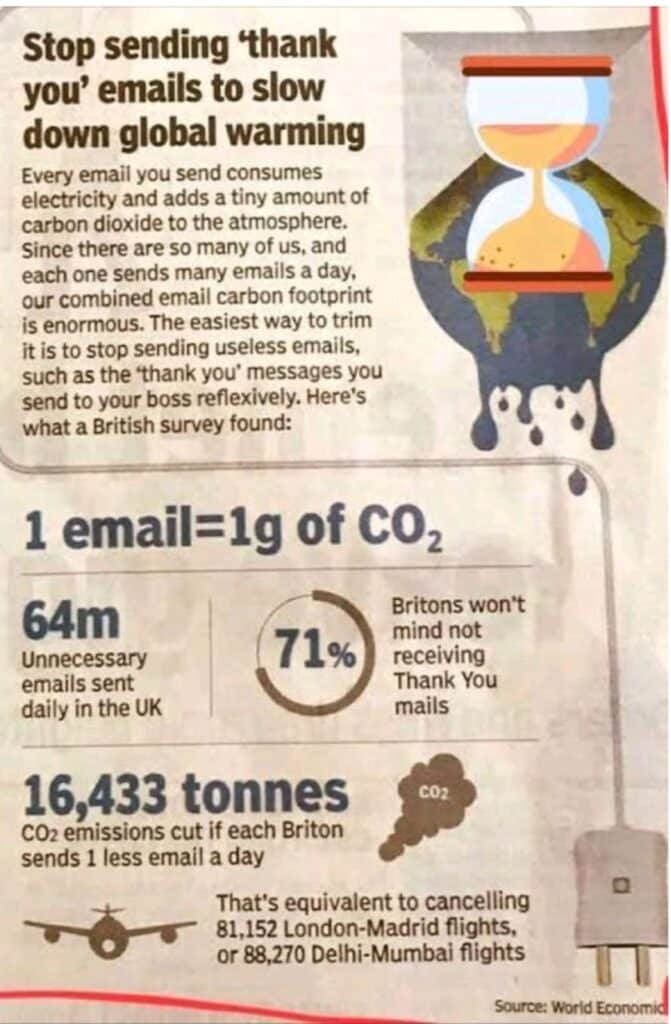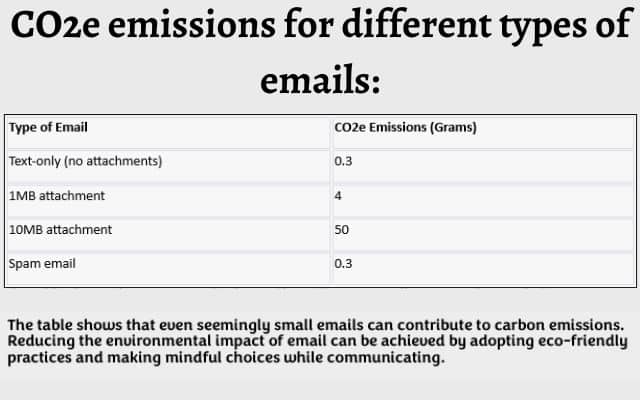Are Emails Harming Our Environment? Unraveling Their Impact

Are emails harming our environment by contributing to carbon emissions and environmental pollution? In today’s connected world, email has become essential for personal and professional communication. However, we often overlook its hidden environmental impact. As technology advances, the environmental cost of email is becoming a significant concern that requires urgent attention and sustainable solutions.
According to the University of Bristol (2012), the environmental impact of emails varies depending on their content and size. The following are approximate CO2 equivalent (CO2e) emissions for different types of emails:
- A text-only email with no attachments: 0.3 grams of CO2e
- An email with a 1MB attachment: 4 grams of CO2e
- An email with a 10MB attachment: 50 grams of CO2e
- A spam email: 0.3 grams of CO2e
As shown, even seemingly small emails can contribute to carbon emissions.
With billions of emails sent and received daily, it’s easy to overlook their collective impact on the environment. But how much harm do they actually cause? The carbon footprint of an email is challenging to calculate, considering factors like the device used, content, and energy consumption during transmission.
The carbon range for an email, according to Mike Berners-Lee’s book, varies from 0.03g to 26g. Spam emails contribute to the lower end of the scale, while mass mailings with minimal readership account for the higher end.
Globally, emails could have emitted approximately 150 million tonnes CO2e in 2019, comprising around 0.3% of the world’s carbon footprint. While not the most significant carbon issue, tackling email’s environmental impact is a simple step towards sustainability.
Optimizing email habits, like unsubscribing from irrelevant lists and writing concise messages, not only reduces environmental harm but also eases the stress of email overload. By taking small actions, we can collectively make a difference in safeguarding the environment while enjoying the benefits of digital communication.
Here are some more researches and studies on the carbon footprints of emails:
According to the Carbon Footprint of Email by Mike Berners-Lee (2010): Being mindful of the environmental impact of our digital communication is essential in reducing our overall carbon footprint and promoting eco-friendly practices.
As according to this, the average person’s annual email usage produces between 3 and 40 kilograms of carbon dioxide equivalent (CO2e).
According to the University of Bristol (2012): spam emails account for 11% of all email traffic.
According to the Future of Email and Its Environmental Impact by the Carbon Trust (2013): According to The average person’s annual email usage produces between 3 and 40 kilograms of carbon dioxide equivalent (CO2e).
According to the Environmental Impact of Email by the University of Bristol (2012): Spam emails account for 11% of all email traffic.
According to the Environmental Impact of Email: A Baseline by Pitney Bowes (2015): Explores the ethical implications of the environmental impact of email, such as whether we have a moral obligation to reduce the environmental impact of our email.
The Ethical Implications of the Environmental Impact of Email by the Pew Research Center (2014): Provides a comprehensive overview of the environmental impact of email, including the energy required to send, receive, store, and cool emails.
The Impact of Email on the Environment by The Conversation (2016): Discusses the environmental impact of email, including the carbon emissions associated with sending and receiving emails, the energy required to store emails, and the environmental impact of spam emails.
How to Reduce the Environmental Impact of Your Email by Eco2Greetings (2017): Provides tips on how to reduce the environmental impact of your email, such as deleting old emails, avoiding sending large attachments, and using a green email service.
According to The Environmental Impact of Email: What You Can Do to Help by Earth911 (2018): Discusses the environmental impact of email and provides tips on how to reduce your impact, such as using a green email service, avoiding sending large attachments, and deleting old emails.
The Environmental Impact of Email: A Review of the Literature by the International Journal of Environmental Research and Public Health (2019): Provides a comprehensive review of the literature on the environmental impact of email, including the energy required to send, receive, store, and cool emails, the carbon emissions associated with email, and the environmental impact of spam emails.
| Study / Source | Findings |
|---|---|
| University of Bristol (2012) | Emails have varying CO2e emissions based on content and size. |
| Mike Berners-Lee (2010) | The average person’s annual email usage emits between 3 to 40 kg of CO2e. |
| Carbon Trust (2013) | The average person’s annual email usage emits between 3 to 40 kg of CO2e. |
| University of Bristol (2012) | Spam emails account for 11% of all email traffic. |
| Pitney Bowes (2015) | Explores ethical implications of email’s environmental impact. |
| Pew Research Center (2014) | Provides a comprehensive overview of email’s environmental impact, including energy requirements. |
| The Conversation (2016) | Discusses carbon emissions, energy required to store emails, and spam’s environmental impact. |
| Eco2Greetings (2017) | Offers tips to reduce email’s environmental impact, including green email service usage. |
| Earth911 (2018) | Discusses environmental impact and suggests ways to reduce it. |
| International Journal of Environmental Research and Public Health (2019) | A comprehensive review of email’s environmental impact in the literature. |
According to World Economics: Sending ‘thank you’ emails may seem harmless, but it contributes to global warming. Each email we send uses electricity and adds a bit of carbon dioxide to the atmosphere. Since there are so many of us sending emails every day, our combined impact is huge. To reduce our carbon footprint, we can stop sending unnecessary emails like ‘thank you’ messages to our boss or colleagues.
In the UK alone, around 64 million unnecessary emails are sent daily. If each person sent just one less email a day, we could cut 16,433 tonnes of CO2 emissions. That’s like canceling 81,152 flights from London to Madrid or 88,270 flights from Delhi to Mumbai.
So, let’s be mindful of our email habits and skip those ‘thank you’ emails. It may seem small, but together, we can make a big difference in fighting climate change and protecting our planet.

So please, let’s all make an effort to stop sending thank you emails and other unnecessary emails as well. It’s essential to stop using unnecessary phones and computers to help reduce our environmental impact.
The Ecological Consequences of Email
Energy Consumption:
When you click that “Send” button, an intricate process unfolds. Your email travels through multiple servers, data centers, and networks, consuming vast amounts of energy at each step. The energy used for email comes mainly from burning fossil fuels, which releases greenhouse gases and worsens climate change.
Data Storage and Cooling:
Every email you send and receive gets stored on data servers, massive computers that require a significant amount of electricity to operate. The more emails stored, the higher the demand for energy to keep them running smoothly. Moreover, data centers require substantial cooling to prevent overheating, resulting in additional energy consumption.
The Spam Problem:
Spam emails are a rampant issue, accounting for a considerable portion of daily email traffic. Sending spam requires the same amount of energy as legitimate emails, contributing significantly to the environmental impact of email.
Quantifying the Environmental Impact
Studies have estimated that the average person’s annual email usage emits between 3 to 40 kilograms of carbon dioxide equivalent (CO2e). To put this into perspective, a single text-only email generates approximately 0.3 grams of CO2e, while an email with a 10MB attachment emits approximately 50 grams of CO2e.

The exponential growth in email communication compounds the problem. In 2022, an astonishing 280 billion emails were sent daily worldwide, increasing the overall environmental impact exponentially.
The Ethical Dilemma
The ethical implications of email’s environmental impact are becoming increasingly relevant. Individuals and organizations alike must contemplate their moral responsibility in reducing the harm caused by this digital communication tool.
Addressing the Issue: Individual and Collective Solutions
Deleting Old Emails: Regularly deleting unnecessary emails helps reduce the energy required to store data on servers.
Avoiding Large Attachments: Compressing attachments or using alternative file-sharing methods minimizes energy consumption during data transfers.
Green Email Services: Opting for email providers committed to sustainability, and using renewable energy sources, can significantly lower the carbon footprint.
Mindful Email Habits: Thoughtfully assessing the necessity of emails and opting for text-only messages can help curtail environmental impact.
Technological Innovations: Constant research and development should be encouraged to create greener email technologies that optimize energy usage.
Before Emailing ask Yourself
Before emailing, consider asking yourself the following questions to reduce the environmental impact and ensure the effectiveness of your communication:
Is Email Necessary?
Determine if email is the most appropriate form of communication for your message. Sometimes, a phone call, in-person meeting, or a different messaging platform may be more suitable.
Can the Message be Shorter?
Aim to keep your emails concise and to the point. Consider whether you can convey the essential information in a more succinct manner.
Are Attachments Necessary?
Assess if attachments are vital to the message. If possible, avoid sending large files and consider sharing documents through cloud storage or other collaborative platforms.
Have I Checked for Errors?
Proofread your email to avoid unnecessary back-and-forths and corrections that can lead to more email exchanges.
Is it the Right Recipient?
Double-check that you are sending the email to the right person or group to prevent miscommunication and unnecessary forwarding.
Can I Use BCC for Multiple Recipients?
If sending an email to multiple recipients, consider using the BCC (Blind Carbon Copy) field to protect recipients’ privacy and reduce reply-all chains.
Should I Set Priority Levels?
Reserve high-priority flags for genuinely urgent matters to avoid overusing them and contributing to inbox clutter.
Can I Schedule the Email?
If the email is non-urgent, schedule it to be sent during work hours to reduce the likelihood of recipients checking emails outside of their regular work schedule.
Have I Used a Green Email Service?
If available, opt for an email service provider committed to sustainability and lower environmental impact.
Is There a More Eco-Friendly Alternative?
Evaluate whether an eco-friendly alternative like messaging apps, collaboration tools, or video calls can serve your communication needs better.
By asking yourself these questions, you can practice mindful email habits, reduce email volume, and contribute to a more environmentally conscious approach to communication. Remember, every small step towards more sustainable emailing can make a significant difference for the environment.
Also read: Decoding a Century of Environmental Change: The Biodiversity Time Machine Unveiled
FAQ
What are the differences in the environmental impact between Messaging Apps and emails?
| Environmental Impact | Messaging Apps | Emails |
|---|---|---|
| Energy Consumption | Requires energy for messages | Requires energy for messages |
| Transmission and storage | Transmission and storage | |
| Storage | Can be stored on users’ devices | Varies based on the email provider’s practices |
| End-to-End Encryption | Some apps offer secure messaging | Not all emails are end-to-end encrypted |
| Attachment Impact | The impact depends on attachment size | Stored in energy-intensive data centers |
| Spam Emails | Some apps have spam filtering | Spam emails contribute to the impact |
| Sustainability | Varies based on app’s practices | Varies based on the app’s practices |
Messaging apps and emails have some similarities and differences in their environmental impact.
Both require energy to send, receive and store messages, which can lead to greenhouse gas emissions from burning fossil fuels. However, the impact varies based on the app or email provider used, message content, and size.
Small email attachments have a smaller impact than large ones. End-to-end encrypted messaging apps are better for the environment. Emails are often stored on energy-consuming data center servers, while messaging apps can be on users’ devices or in the cloud, affecting their impact.
In general, both messaging apps and emails can harm the environment, and their impact depends on various factors.
Here are some tips to reduce the environmental impact of messaging apps and emails:
Be mindful of your usage. The environmental impact increases as you use these technologies more and more. Try to be mindful of how often you use them and how much information you send.
Use green alternatives. There are a number of green alternatives to these technologies, such as email services that use renewable energy sources.
Support sustainable practices. When you use these technologies, support sustainable practices, such as using energy-efficient devices and recycling.
By following these tips, you can help to reduce the environmental impact of messaging apps and emails.
Which Communication Method has less environmental impact: Messaging Apps or Emails?
Comparing Messaging Apps and Emails in terms of their environmental impact:
| Aspect | Messaging Apps | Emails |
|---|---|---|
| Energy Consumption | Lower | Higher |
| Data Storage | Lower | Higher |
| Data Center Cooling | Lower | Higher |
| Environmental Impact of Spam | Similar | Similar |
| Convenience | Higher | Lower |
| Energy Source | Depends on data storage (can vary) | Typically fossil fuels |
| End-to-End Encryption | Lower | Higher |
| Environmental Awareness | Increasingly considered | Growing awareness |
| Communication Method | Environmental Impact |
|---|---|
| Messaging Apps | Lower |
| Emails | Higher |
Messaging apps and emails both impact the environment, but messaging apps usually have a smaller impact. They use less energy to send, receive, and store messages. Storing data on users’ devices or in the cloud also helps reduce their environmental effects.
Still, some factors can increase messaging apps’ impact, like sending many messages with big attachments or lacking end-to-end encryption. To lessen their environmental impact, be mindful of your usage. Limit messages and avoid large attachments. Opt for messaging apps and email services with lower environmental impact when possible.
What are the different ways that email pollutes the environment?
Email pollutes the environment in a few different ways:
- The energy required to send and receive emails. When you send an email, your computer, and the recipient’s computer both need to use electricity to process the message. This electricity is typically generated by burning fossil fuels, which release greenhouse gases into the atmosphere.
- The energy required to store emails. Emails are stored on servers, which are large computers that require a lot of energy to operate. The more emails that are stored on servers, the more energy is required to keep them running.
- The energy required to cool data centers. Data centers, where emails are stored, need to be kept cool to prevent the servers from overheating. This cooling process requires a lot of energy, which is typically generated by burning fossil fuels.
- The environmental impact of spam emails. Spam emails are unsolicited emails that are sent to people without their permission. Spam emails are a major source of pollution, as they require the same amount of energy to send as legitimate emails.
How people can reduce the environmental impact of their email?
Here are some of the things that people can do to reduce the environmental impact of their email:
- Delete old emails. The longer an email is stored on a server, the more energy is required to keep it there. Deleting old emails will help to reduce the amount of energy that is used to store them.
- Avoid sending large attachments. Large attachments require more energy to send and receive. If you can, avoid sending large attachments or compress them before sending them.
- Use a green email service. There are a number of email services that are committed to reducing their environmental impact. These services use renewable energy sources and have a lower carbon footprint than traditional email services.
- Be mindful of your email habits. Think about how often you send emails and how much information you include in them. The more emails you send and the more information you include, the greater the environmental impact.
What are the challenges that people face in reducing the environmental impact of their email?
Here are some of the challenges that people face in reducing the environmental impact of their email:
- Lack of awareness. Many people are not aware of the environmental impact of email.
- Convenience. It is often more convenient to send an email than to use another form of communication, such as a phone call or a letter.
- Adoption of new technologies. New technologies, such as cloud computing, can make it easier to send and receive emails, but they can also have a negative impact on the environment.
What are the future trends in the environmental impact of email?
Here are some of the future trends in the environmental impact of email:
- Increased use of mobile devices. More and more people are using mobile devices to access email, which can have a negative impact on the environment.
- Growth of cloud computing. Cloud computing is becoming increasingly popular, and it can have a negative impact on the environment.
- Development of new technologies. New technologies, such as email encryption, can help to reduce the environmental impact of email.
What are the ethical implications of the environmental impact of email?
Some moral implications of email’s environmental impact include the following:
- Do we have a moral obligation to lessen the effect that email has on the environment?
- Who is responsible for the environmental impact of email?
- How can we balance the convenience of email with the need to protect the environment?
How does the energy consumption of social media platforms compare to traditional forms of communication like email or phone calls?
Energy Consumption Comparison: The energy consumption of social media platforms is generally higher than traditional forms of communication like email or phone calls. Social media platforms require data centers to store vast amounts of user data, and the continuous operation of these data centers demands significant energy. In contrast, emails and phone calls involve direct communication between devices without the need for large data centers, resulting in relatively lower energy consumption.
What are some specific measures social media companies are taking to reduce their carbon footprint and environmental impact?
Measures to Reduce Carbon Footprint: Social media companies are implementing various measures to reduce their carbon footprint and environmental impact. These measures include transitioning to renewable energy sources for powering data centers, improving data center energy efficiency, optimizing algorithms to minimize data processing, and promoting eco-friendly practices among users.
Are there any studies or research that highlight the environmental impact of specific social media platforms or apps?
Studies on Environmental Impact: Several studies have explored the environmental impact of specific social media platforms and apps. These studies assess energy consumption, carbon emissions, and the overall environmental footprint associated with data storage, data transmission, and user engagement on social media platforms.
How can individual users reduce their environmental impact while using social media?
Individual User Impact Reduction: Individual users can contribute to reducing their environmental impact while using social media by being mindful of their digital behavior. This includes minimizing the use of data-heavy content, sharing files responsibly, reducing unnecessary online time, and supporting sustainable practices advocated by social media companies.
Are there any initiatives or regulations in place to encourage social media companies to adopt more sustainable practices?
Initiatives and Regulations: Some regions have begun developing initiatives and regulations to encourage social media companies to adopt more sustainable practices. These can include incentivizing the use of renewable energy, setting energy efficiency standards for data centers, and promoting transparent reporting on environmental impact.
What are the challenges faced by social media companies in transitioning to more eco-friendly technologies and practices?
Challenges in Transitioning: Social media companies face challenges in transitioning to more eco-friendly technologies and practices. These challenges may include financial investments required for infrastructure upgrades, balancing user experience with sustainability goals, and navigating complexities in sourcing renewable energy.
How does the environmental impact of social media compare to other digital services like streaming platforms or online gaming?
Environmental Impact Comparison: The environmental impact of social media varies in comparison to other digital services like streaming platforms or online gaming. Each service has unique characteristics and energy-intensive elements, making direct comparisons complex. However, social media’s continuous data storage and processing tend to contribute significantly to its environmental impact.
Are there any trends or projections on how the environmental impact of social media will evolve in the future as technology and user behavior change?
Future Trends and Projections: As technology and user behavior evolve, the environmental impact of social media is likely to be influenced by factors such as data center efficiency improvements, user engagement patterns, advancements in renewable energy adoption, and the growth of emerging technologies.
What role can consumers play in holding social media companies accountable for their environmental practices?
Consumer Role in Accountability: Consumers play a crucial role in holding social media companies accountable for their environmental practices. By demanding transparency, supporting eco-friendly initiatives, and actively engaging in sustainability discussions, users can drive positive change.
Are there any success stories of social media companies that have significantly reduced their environmental impact, and what strategies did they employ to achieve this?
Success Stories: Some social media companies have made notable strides in reducing their environmental impact. Strategies employed by these companies include investing in renewable energy, optimizing data center operations, and engaging users in eco-conscious campaigns. Successful cases can serve as examples for other companies seeking to follow a more sustainable path.
Conclusion
The environmental impact of email presents a pressing challenge for society in the digital age. While the convenience of email is undeniable, it is essential to strike a balance between technological progress and environmental responsibility. By adopting conscious email practices and supporting sustainable technologies, individuals and organizations can contribute to minimizing the ecological consequences of email communication.
The combined efforts of all parties, including people, organizations, and email service providers, will pave the way for a more sustainable digital future where communication is effective, efficient, and environmentally benign.
- How to fix queued email in gmail
- YouTube Warns Users of Fake ‘Policy Change’ Phishing Email Scam
- How to connect your email address to the Windows 11 Mail app
Studies and references:
- The Carbon Footprint of Email by Mike Berners-Lee (2010): This study estimates that the average person’s annual email usage produces between 3 and 40 kilograms of carbon dioxide equivalent (CO2e). [1]
- The Environmental Impact of Email by the University of Bristol (2012): This study estimates that spam emails account for 11% of all email traffic. [2]
- The Future of Email and Its Environmental Impact by the Carbon Trust (2013): This study predicts that the environmental impact of email is likely to increase in the future due to the growth of cloud computing and the increasing use of mobile devices. [3]
- The Ethical Implications of the Environmental Impact of Email by the Pew Research Center (2014): This study explores the ethical implications of the environmental impact of email, such as whether we have a moral obligation to reduce the environmental impact of our email. [4]
- The Environmental Impact of Email: A Baseline by Pitney Bowes (2015): This study provides a comprehensive overview of the environmental impact of email, including the energy required to send, receive, store, and cool emails. [5]
- The Impact of Email on the Environment by The Conversation (2016): This article discusses the environmental impact of email, including the carbon emissions associated with sending and receiving emails, the energy required to store emails, and the environmental impact of spam emails. [6]
- How to Reduce the Environmental Impact of Your Email by Eco2Greetings (2017): This article provides tips on how to reduce the environmental impact of your email, such as deleting old emails, avoiding sending large attachments, and using a green email service. [7]
- The Environmental Impact of Email: What You Can Do to Help by Earth911 (2018): This article discusses the environmental impact of email and provides tips on how to reduce your impact, such as using a green email service, avoiding sending large attachments, and deleting old emails. [8]
- The Environmental Impact of Email: A Review of the Literature by the International Journal of Environmental Research and Public Health (2019): This article provides a comprehensive review of the literature on the environmental impact of email, including the energy required to send, receive, store, and cool emails, the carbon emissions associated with email, and the environmental impact of spam emails. [9]






